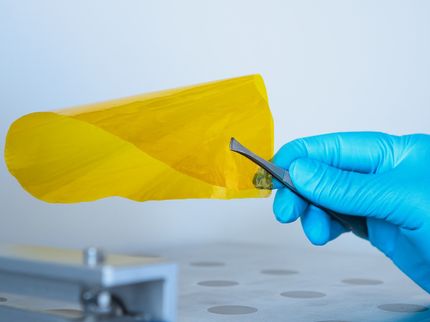Hydrogen: Breakthrough in alkaline membrane electrolyzers
Advertisement
A team from the Technical University of Berlin, HZB, IMTEK (University of Freiburg) and Siemens Energy has succeeded in developing an alkaline membrane electrolyzer that comes close to the performance of established PEM electrolyzers. The special feature: The anode catalyst consists of inexpensive nickel compounds and not iridium. At BESSY II, the team was able to clarify the catalytic processes in detail. In Freiburg, prototype cells were built using a new coating process and tested in operation.
Hydrogen is set to play a major role in the energy system of the future, as an energy store, fuel and valuable raw material for the chemical industry. This is because hydrogen can be produced in an almost climate-neutral way by electrolyzing water, provided this is done using electricity from the sun or wind. The ramp-up of the green hydrogen economy is currently largely determined by two systems: proton-conducting membrane electrolysis (PEM) and classic alkaline electrolysis. AEM electrolysers combine the advantages of both systems and, for example, do not require rare precious metals such as iridium.
Now, research teams from TU Berlin and HZB, together with the Institute of Microsystems Engineering (IMTEK) at the University of Freiburg and Siemens Energy, have for the first time presented an electrolyzer that produces hydrogen almost as efficiently as a PEM electrolyzer. Instead of iridium, they used nickel double hydroxide compounds with iron, cobalt or manganese and developed a process to coat an alkaline ion exchange membrane directly with them.
During electrolysis in the cell, they were able to carry out operando measurements at the Berlin X-ray source BESSY II at the LIXEdrom end station. A theory team from Singapore and the USA helped to interpret the experimental data. "This enabled us to elucidate the relevant catalytic-chemical processes on the catalyst-coated membrane, in particular the phase transition from a catalytically inactive alpha phase to the highly active gamma phase and the role that the various O ligands and Ni4+ centers play in catalysis," explains Prof. Peter Strasser, TU Berlin. "Only this gamma phase makes our catalyst competitive with the current state-of-the-art catalysts made of iridium. Our work shows important similarities to iridium in the catalytic mechanism, but also completely surprising molecular differences."
The study has thus significantly expanded the understanding of the fundamental catalysis mechanisms of the new nickel-based electrode materials. In addition, the newly developed coating process for the membrane electrode promises very good scalability. The first fully functional small cell has already been tested at IMTEK. The work thus lays the foundation for industrial evaluation and demonstrates that an AEM water electrolyser can also be highly efficient.
Note: This article has been translated using a computer system without human intervention. LUMITOS offers these automatic translations to present a wider range of current news. Since this article has been translated with automatic translation, it is possible that it contains errors in vocabulary, syntax or grammar. The original article in German can be found here.
Original publication
M. Klingenhof, H. Trzesniowski, S. Koch, J. Zhu, Z. Zeng, L. Metzler, A. Klinger, M. Elshamy, F. Lehmann, P. W. Buchheister, A. Weisser, G. Schmid, S. Vierrath, F. Dionigi, P. Strasser; "High-performance anion-exchange membrane water electrolysers using NiX (X = Fe,Co,Mn) catalyst-coated membranes with redox-active Ni–O ligands"; Nature Catalysis, 2024-10-28

































































